From this month, all cattle going through the ICBF progeny test centre in Tully, Co Kildare, have their methane emissions measured in an effort to include climate efficiency among breeding criteria.
Centre manager Stephen Conroy showed the Irish Farmers Journal the €600,000 investment at Tully, which includes a shed extension to expand the centre’s 500 head capacity by a third, and four Greenfeed machines to measure the amount of greenhouse gases released by cattle. “We want to tell farmers that an animal producing a given weight will release less methane,” said Conroy. “And that’s less feed used, so less cost for farmers,” added Paul Smith, who conducts the measurements and analysis with Teagasc.
The animals kept at Tully are groups of 20 progeny from each AI bull being assessed by the ICBF. The data on their feed efficiency is already being measured for inclusion in their sire’s breeding index. Current research will ultimately add a measure of their impact on climate change to the index. Methane released by cattle is the largest cause of greenhouse gas emissions from agriculture in Ireland.
Radio chip
Each animal is fitted with a radio chip, which identifies how much each of them eats from Insentec connected feed bins, and how much gas they release into Greenfeed machines.

Greenfeed machine used to measure methane emissions from cattle at the ICBF progeny test centre in Tully, Co Kildare. \ Thomas Hubert
The US-made devices dispense a small amount of concentrates to attract the cattle and allow access to each animal every four hours, hoovering up the air around their head. Sensors measure the amount of methane they breathe and belch out, and Paul can check the data from his phone or computer. There is a visible spike in methane emissions three to four hours after cattle eat their ration, he said, as their rumen gets active.
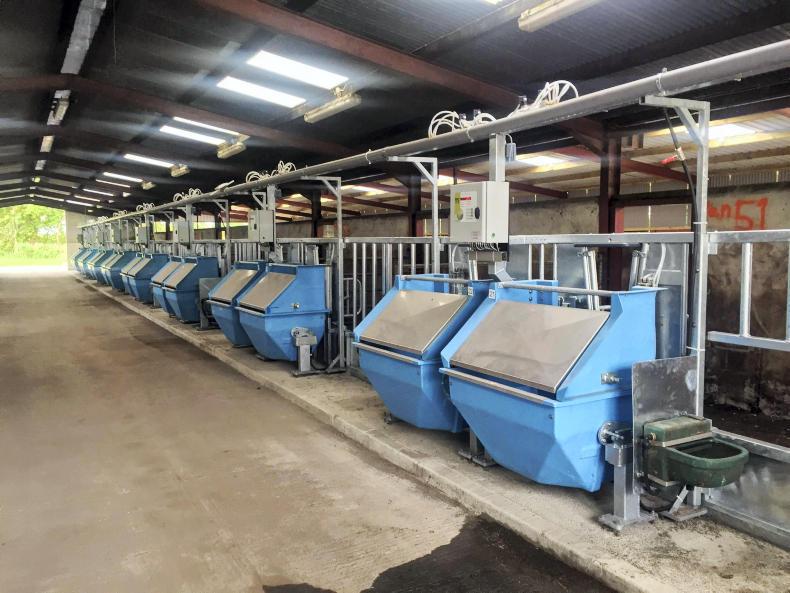
Connected bins to measure feed efficiency of cattle at the ICBF progeny test centre in Tully, Co Kildare. \ Thomas Hubert
The expanded research is part of the Greenbreed project, for which Minister for Agriculture Michael Creed announced €3m in funding last year. The project also covers dairy (see ifj.ie/greendairy) and sheep (see ifj.ie/greensheep). It builds upon the existing RumenPredict and MASTER projects initiated by Teagasc in collaboration with UCD and the ICBF. Initial results from 81 animals tested so far show they emit 210g of methane each day on average. Paul said he had observed a 20% difference in emissions between the top and bottom halves of his cattle league table (see Table 1). Heifers had slightly higher emissions than steers (+6%). More research is needed to confirm those results and isolate them from other factors such as age and weight details. Animals of all breeds are to be tested.
Methane intensity
Paul also cross-references emission figures with other data for analysis. “The methane intensity per kg of animal produced is my favourite: if you can reduce methane per kg produced you could in theory feed more people for the same or less emissions,” he said.
In parallel, Paul takes a sample from the rumen of each animal to analyse its microbiology. “The idea is to understand which bugs are involved in methane production,” he said. Some microbes called methanogens are known to produce the greenhouse gas, but they interact with others such as bacteria, providing the environment for them to grow. Together, they divert around 12% of feed energy into methane. “We want to select animals to redirect this to growth, pregnancy or milk,” Paul said.

Cattle having methane emissions measured at the ICBF progeny test centre in Tully, Co Kildare. \ Thomas Hubert
Research has already shown that different cattle have different microbes in their gut. The cherry on the cake would be to find where in the animals’ genetic make-up those climate and feed efficiency traits are written. Paul said current research includes going through the cattle’s DNA to see if a section is associated with lower methane emissions.

Greenfeed machine used to measure methane emissions from cattle at the ICBF progeny test centre in Tully, Co Kildare. \ Thomas Hubert
“But we’ll be able to link sires to that trait even without the DNA marker,” Conroy added.
Why breed more climate-efficient cattle when promising research may deliver feed additives or vaccines that reduce methane emissions in the near future? According to Paul Smith, chemicals solutions to eliminate methanogens in the rumen may have unwanted side effects. “Without them, you would have too much hydrogen in the rumen and may reduce the ability of animals to ferment feed further,” he warned. Also, some chemical solutions appear to be persistent and need frequent administration at a constant cost to farmers, while genetic gain is permanent, he added. Another challenge would be to deliver additives when cattle are at grass. More research is planned, and Stephen Conroy said solar-powered Greenfeed machines could be used to measure emissions from cattle in fields.

The new shed extension at the ICBF progeny test centre in Tully, Co Kildare. \ Thomas Hubert
Read more
Methane emissions in EBI by 2023
When sheep genetics meet methane emissions
Multi-million acceleration for research into climate-friendly cattle
From this month, all cattle going through the ICBF progeny test centre in Tully, Co Kildare, have their methane emissions measured in an effort to include climate efficiency among breeding criteria.
Centre manager Stephen Conroy showed the Irish Farmers Journal the €600,000 investment at Tully, which includes a shed extension to expand the centre’s 500 head capacity by a third, and four Greenfeed machines to measure the amount of greenhouse gases released by cattle. “We want to tell farmers that an animal producing a given weight will release less methane,” said Conroy. “And that’s less feed used, so less cost for farmers,” added Paul Smith, who conducts the measurements and analysis with Teagasc.
The animals kept at Tully are groups of 20 progeny from each AI bull being assessed by the ICBF. The data on their feed efficiency is already being measured for inclusion in their sire’s breeding index. Current research will ultimately add a measure of their impact on climate change to the index. Methane released by cattle is the largest cause of greenhouse gas emissions from agriculture in Ireland.
Radio chip
Each animal is fitted with a radio chip, which identifies how much each of them eats from Insentec connected feed bins, and how much gas they release into Greenfeed machines.

Greenfeed machine used to measure methane emissions from cattle at the ICBF progeny test centre in Tully, Co Kildare. \ Thomas Hubert
The US-made devices dispense a small amount of concentrates to attract the cattle and allow access to each animal every four hours, hoovering up the air around their head. Sensors measure the amount of methane they breathe and belch out, and Paul can check the data from his phone or computer. There is a visible spike in methane emissions three to four hours after cattle eat their ration, he said, as their rumen gets active.

Connected bins to measure feed efficiency of cattle at the ICBF progeny test centre in Tully, Co Kildare. \ Thomas Hubert
The expanded research is part of the Greenbreed project, for which Minister for Agriculture Michael Creed announced €3m in funding last year. The project also covers dairy (see ifj.ie/greendairy) and sheep (see ifj.ie/greensheep). It builds upon the existing RumenPredict and MASTER projects initiated by Teagasc in collaboration with UCD and the ICBF. Initial results from 81 animals tested so far show they emit 210g of methane each day on average. Paul said he had observed a 20% difference in emissions between the top and bottom halves of his cattle league table (see Table 1). Heifers had slightly higher emissions than steers (+6%). More research is needed to confirm those results and isolate them from other factors such as age and weight details. Animals of all breeds are to be tested.
Methane intensity
Paul also cross-references emission figures with other data for analysis. “The methane intensity per kg of animal produced is my favourite: if you can reduce methane per kg produced you could in theory feed more people for the same or less emissions,” he said.
In parallel, Paul takes a sample from the rumen of each animal to analyse its microbiology. “The idea is to understand which bugs are involved in methane production,” he said. Some microbes called methanogens are known to produce the greenhouse gas, but they interact with others such as bacteria, providing the environment for them to grow. Together, they divert around 12% of feed energy into methane. “We want to select animals to redirect this to growth, pregnancy or milk,” Paul said.

Cattle having methane emissions measured at the ICBF progeny test centre in Tully, Co Kildare. \ Thomas Hubert
Research has already shown that different cattle have different microbes in their gut. The cherry on the cake would be to find where in the animals’ genetic make-up those climate and feed efficiency traits are written. Paul said current research includes going through the cattle’s DNA to see if a section is associated with lower methane emissions.

Greenfeed machine used to measure methane emissions from cattle at the ICBF progeny test centre in Tully, Co Kildare. \ Thomas Hubert
“But we’ll be able to link sires to that trait even without the DNA marker,” Conroy added.
Why breed more climate-efficient cattle when promising research may deliver feed additives or vaccines that reduce methane emissions in the near future? According to Paul Smith, chemicals solutions to eliminate methanogens in the rumen may have unwanted side effects. “Without them, you would have too much hydrogen in the rumen and may reduce the ability of animals to ferment feed further,” he warned. Also, some chemical solutions appear to be persistent and need frequent administration at a constant cost to farmers, while genetic gain is permanent, he added. Another challenge would be to deliver additives when cattle are at grass. More research is planned, and Stephen Conroy said solar-powered Greenfeed machines could be used to measure emissions from cattle in fields.

The new shed extension at the ICBF progeny test centre in Tully, Co Kildare. \ Thomas Hubert
Read more
Methane emissions in EBI by 2023
When sheep genetics meet methane emissions
Multi-million acceleration for research into climate-friendly cattle













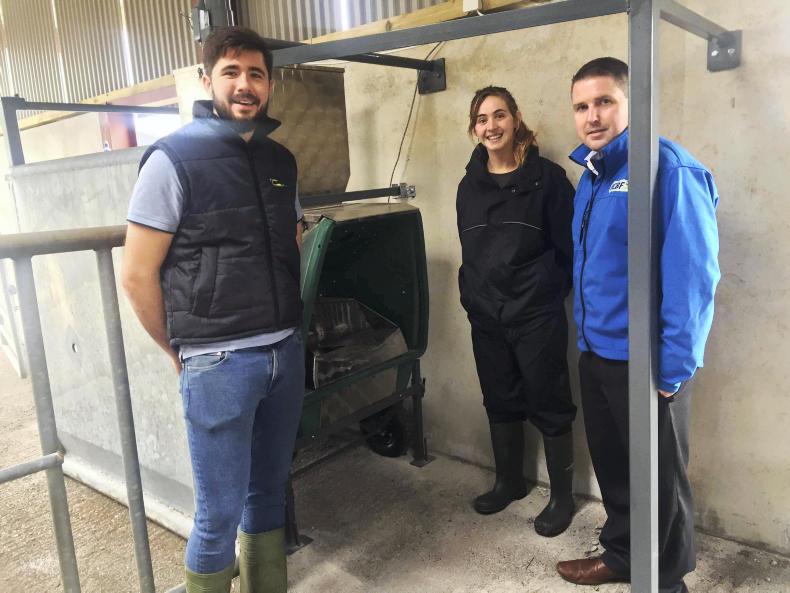
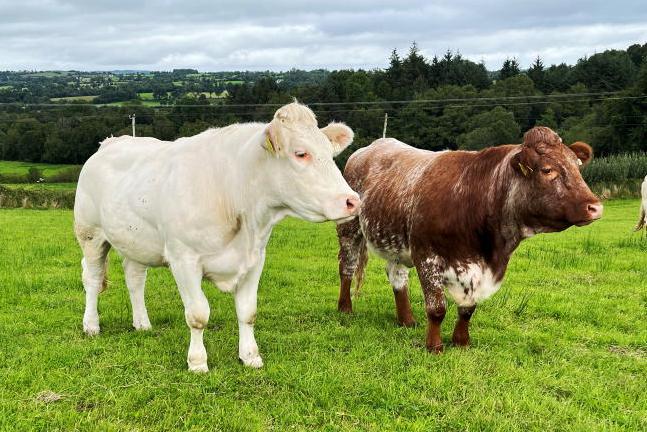

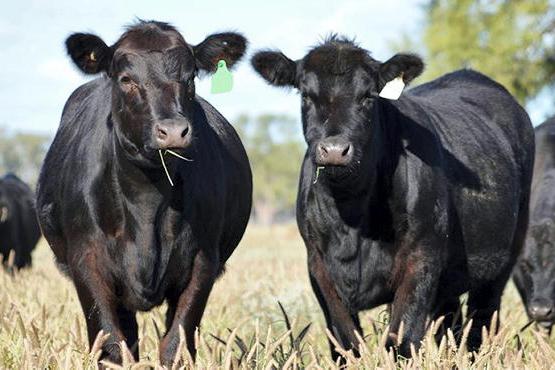
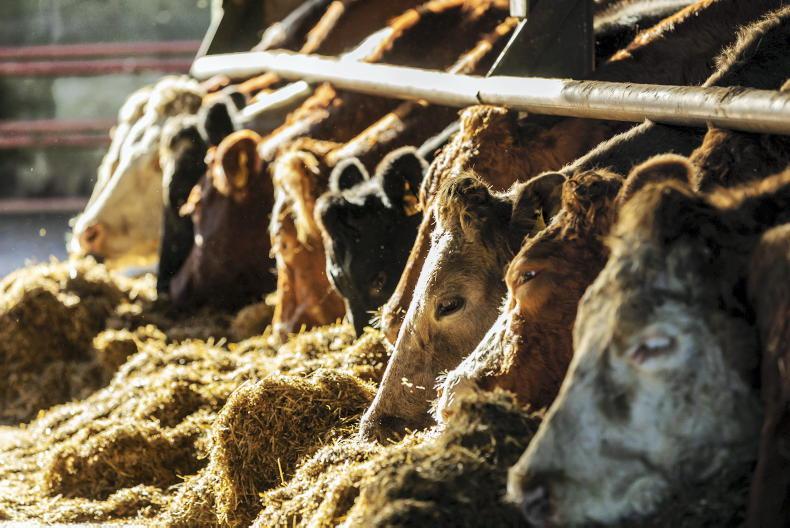
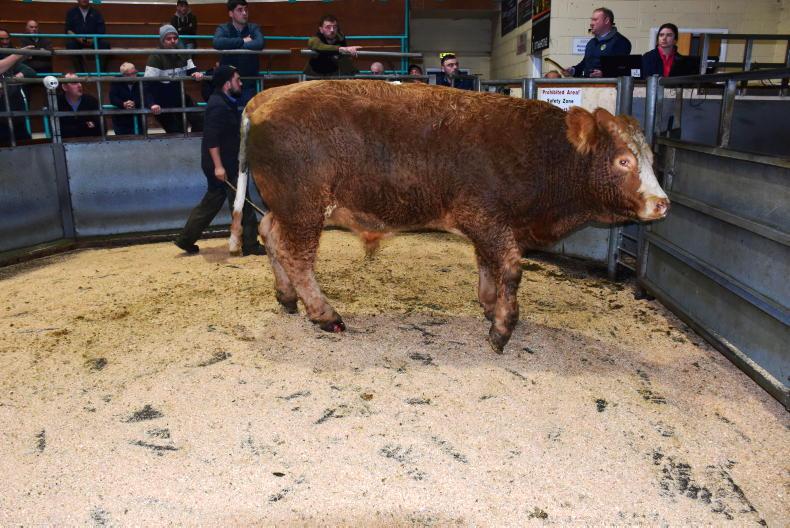
SHARING OPTIONS